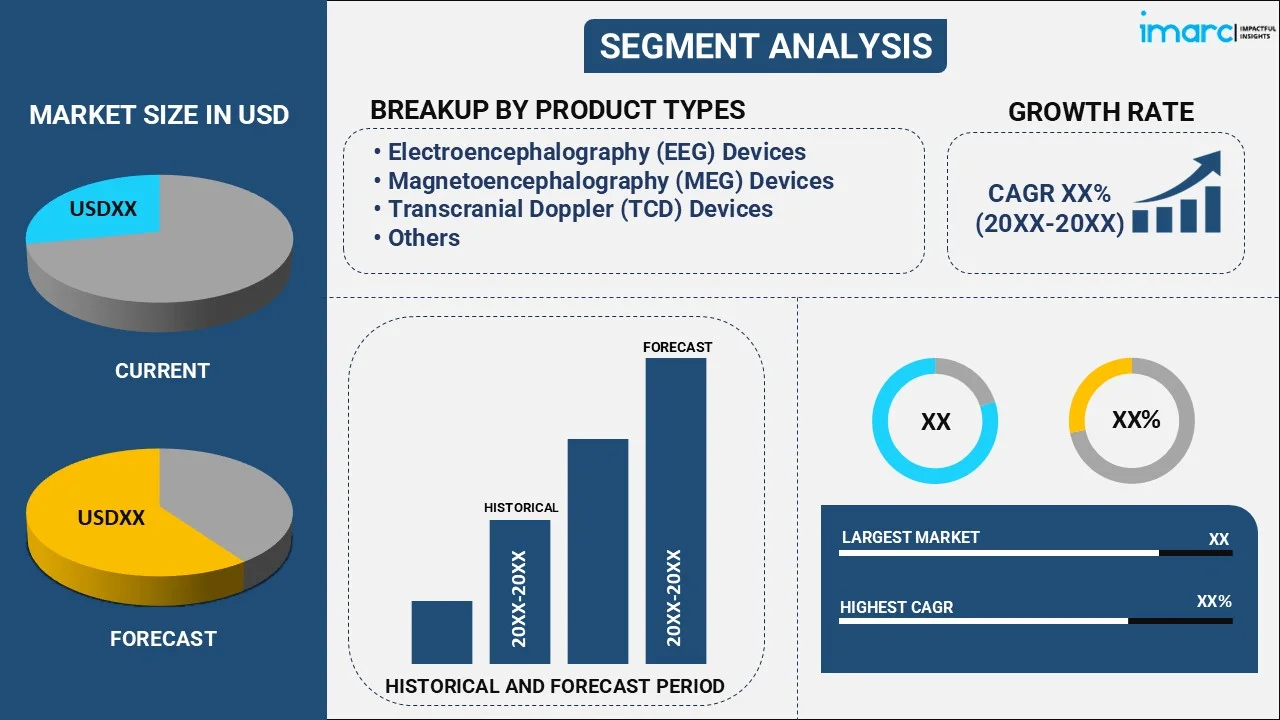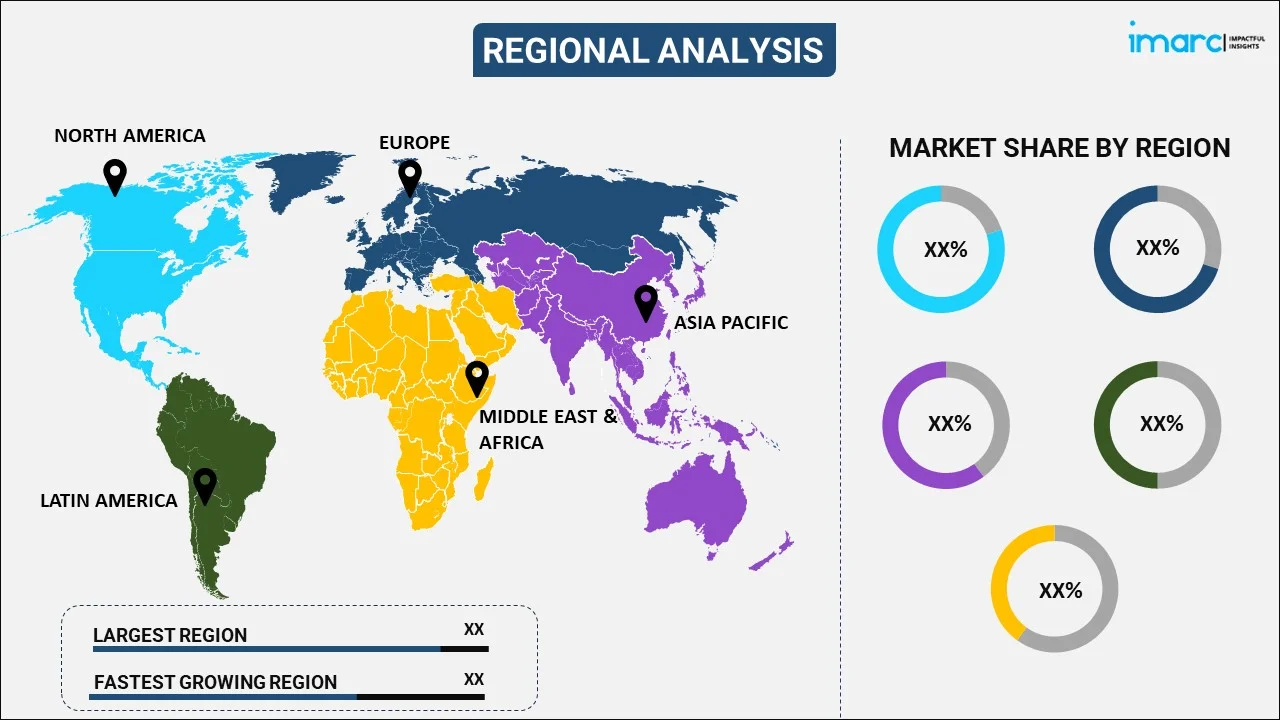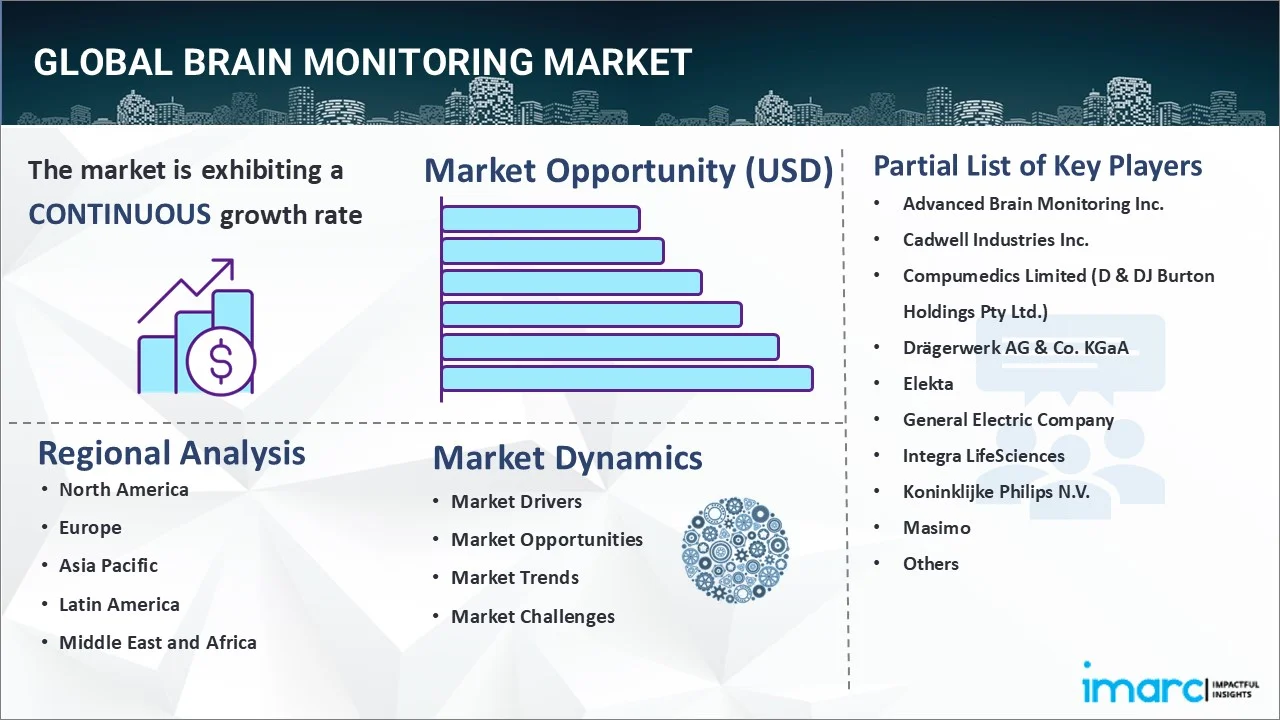
Brain Monitoring Market Report by Product Type (Electroencephalography (EEG) Devices, Magnetoencephalography (MEG) Devices, Transcranial Doppler (TCD) Devices, Intracranial Pressure (ICP) Monitors, Cerebral Oximeters, Magnetic Resonance Imaging (MRI) Devices, Computerized Tomography (CT) Devices, Positron Emission Tomography (PET) Devices, Sleep Monitoring Devices, Electromyography (EMG) Devices, Accessories), Procedure (Invasive, Non-invasive), Application (Parkinson’s Disease, Traumatic Brain Injury (TBI), Epilepsy, Dementia, Sleep Disorders, and Others), End User (Hospitals, Diagnostic Centers), and Region 2025-2033
Global Brain Monitoring Market:
The global brain monitoring market size reached USD 6.8 Billion in 2024. Looking forward, the market is expected to reach USD 11.1 Billion by 2033, exhibiting a growth rate (CAGR) of 5.6% during 2025-2033. Growing incidences of neurological disorders, technological advancements in brain monitoring devices, surging focus on brain health, and aging population are primarily driving the market growth.
|
Report Attribute
|
Key Statistics
|
|---|---|
|
Base Year
|
2024
|
|
Forecast Years
|
2025-2033
|
|
Historical Years
|
2019-2024
|
|
Market Size in 2024
|
USD 6.8 Billion |
|
Market Forecast in 2033
|
USD 11.1 Billion |
| Market Growth Rate (2025-2033) | 5.6% |
Brain Monitoring Market Analysis:
- Major Market Drivers: The increasing prevalence of neurodegenerative diseases among the masses coupled with the rising geriatric population is stimulating the market growth. Moreover, with the advent of wireless technology, continual technological advancements and the miniaturization of medical devices, the size of various brain monitoring devices has been greatly reduced, which, in turn, is resulting in the greater adoption of these devices.
- Key Market Trends: The rising demand for non-invasive and minimally invasive procedures is providing an impetus to the market growth. Apart from this, continual developments in the healthcare infrastructure and extensive research and development (R&D) activities conducted by key players are escalating the market demand.
- Competitive Landscape: Some of the prominent companies in the market include Advanced Brain Monitoring Inc., Cadwell Industries Inc., Compumedics Limited (D & DJ Burton Holdings Pty Ltd.), Drägerwerk AG & Co. KGaA, Elekta, General Electric Company, Integra LifeSciences, Koninklijke Philips N.V., Masimo, Medtronic plc, Natus Medical Incorporated, Nihon Kohden Corporation, Siemens Healthineers AG (Siemens AG), and Spiegelberg GmbH & Co. KG., among many others.
- Geographical Trends: The North America region benefits from extensive research and development activities in neurology and neuroscience, contributing to technological advancements in brain monitoring devices. Moreover, European countries have well-established healthcare systems, robust research capabilities, and favorable reimbursement policies, which foster the market growth. Apart from this, rapid economic growth and improving healthcare infrastructure contribute to the Asia Pacific market growth.
- Challenges and Opportunities: The high cost of technology, regulatory hurdles, and privacy and ethical concerns are some of the challenges that the market is facing. However, continuous advancements in neuroimaging technologies, AI, and machine learning present opportunities for developing more accurate and efficient brain monitoring devices.
Brain Monitoring Market Trends:
Rising Prevalence of Neurological Disorders
The rising prevalence of neurological disorders is a significant factor influencing the growth of the brain monitoring market. As populations around the world age, the incidence of age-related neurological disorders such as Alzheimer's disease and Parkinson's disease increases. For instance, according to an article published by the National Library of Medicine, the aging population has significantly increased the societal burden of various neurologic illnesses, including Alzheimer's disease, primary malignant brain tumors, Parkinson's disease, and amyotrophic lateral sclerosis. Moreover, according to the World Health Organization (WHO), nearly 14% of adults aged 60 and above live with a mental disorder. Apart from this, as neurological disorders become more prevalent, there is a growing need for advanced diagnostic tools to accurately detect and monitor these conditions. Brain monitoring technologies such as EEG (electroencephalography), MRI (magnetic resonance imaging), and PET (positron emission tomography) scans play a crucial role in the diagnosis and assessment of neurological disorders. For instance, in April 2024, Soterix Medical Inc., a non-invasive brain stimulation and synergistic monitoring technologies provider, launched MxN-GO EEG, a high-definition transcranial Electrical Stimulation (HD-tES) and EEG system with a unique untethered design. The technology is designed for research applications that need electrical stimulation and monitoring of brain activity in mobile and natural settings. These factors are further proliferating the market growth.
Increasing Application of Electroencephalography (EEG)
The increasing application of Electroencephalography (EEG) is significantly driving the growth in the brain monitoring market. EEG is essential for diagnosing various neurological disorders such as epilepsy, sleep disorders, and brain tumors. Its ability to detect abnormal electrical activity in the brain helps in accurate diagnosis, guiding treatment decisions and improving patient outcomes. For instance, in July 2022, the National Institute of Health performed a survey of hospitals in the United States and discovered that using EEG equipment dramatically improved electrographic seizure diagnosis by physicians. The sensitivity of electrographic seizure diagnosis increased from 77.8% to 100%, while the specificity increased from 63.9% to 89% when compared to clinical diagnosis. Continuous advancements in EEG technology, such as high-density EEG, portable devices, and improved signal processing techniques, enhance its diagnostic capabilities and usability. For instance, in April 2024, NeuroVigil introduced the iBrain personal brain monitor in the United States, which is an investigational portable gadget that can non-invasively record electrical activity in persons with neurological problems. iBrain is based on electroencephalogram (EEG) technology, which is routinely used to assess brain electrical activity and detect neurological abnormalities. Patients can use the gadget at home and during sleep to acquire EEG data more efficiently and easily. These technological improvements make EEG more accessible and reliable across diverse healthcare settings, fostering broader adoption and market expansion. These factors are further contributing to the brain monitoring market share.
Emerging Neuroscience Research
Increasing neuroscience research is contributing to the growth of the brain monitoring market. Research in neuroscience continually pushes the boundaries of brain imaging technologies such as MRI (Magnetic Resonance Imaging), PET (Positron Emission Tomography), CT (Computed Tomography), and EEG (Electroencephalography). For instance, in May 2024, GE HealthCare unveiled SIGNA MAGNUS, a cutting-edge head-only magnetic resonance imaging (MRI) scanner. SIGNA MAGNUS is a major advancement that gives scientists a strong instrument to examine the intricacies of the brain in depth. These technologies are crucial for visualizing and understanding brain structure, function, and connectivity in both healthy individuals and those with neurological disorders. Besides this, neuroscience research increasingly leverages AI and machine learning algorithms to analyze large-scale brain imaging and EEG data. These advanced analytical tools enhance the interpretation of complex brain activity patterns, identify subtle biomarkers, and predict disease progression. Also, various organizations are promoting applications of artificial intelligence in brain illnesses in order to provide better diagnostics. For instance, in February 2024, the 10,000 Brains Project, an independent non-profit organization, was launched to promote the ethical application of artificial intelligence (AI) in the battle against Alzheimer's, Parkinson's, and other neurological illnesses. The organization's aim is to provide the leadership, experience, and financial assistance required to ensure that researchers can quickly adopt this powerful new technology in the pursuit of better diagnostics and treatments for patients in need. These factors are further escalating the market demand.
Global Brain Monitoring Industry Segmentation:
IMARC Group provides an analysis of the key trends in each segment of the global brain monitoring market report, along with forecasts at the global, regional, and country levels from 2025-2033. Our report has categorized the market based on product type, procedure, application, and end user.
Breakup by Product Type:

- Electroencephalography (EEG) Devices
- Magnetoencephalography (MEG) Devices
- Transcranial Doppler (TCD) Devices
- Intracranial Pressure (ICP) Monitors
- Cerebral Oximeters
- Magnetic Resonance Imaging (MRI) Devices
- Computerized Tomography (CT) Devices
- Positron Emission Tomography (PET) Devices
- Sleep Monitoring Devices
- Electromyography (EMG) Devices
- Accessories
The report has provided a detailed breakup and analysis of the market based on the product type. This includes Electroencephalography (EEG) Devices, Magnetoencephalography (MEG) Devices, Transcranial Doppler (TCD) Devices, Intracranial Pressure (ICP) Monitors, Cerebral Oximeters, Magnetic Resonance Imaging (MRI) Devices, Computerized Tomography (CT) Devices, Positron Emission Tomography (PET) Devices, Sleep Monitoring Devices, Electromyography (EMG) Devices, and Accessories.
The demand for electroencephalography (EEG) devices is driven by the surging prevalence of epilepsy and sleep disorders. Moreover, magnetoencephalography (MEG) devices are essential for pre-surgical localization of epileptic foci and brain tumor mapping. Apart from this, the increasing incidence of stroke requiring monitoring of cerebral blood flow is bolstering the demand for transcranial doppler devices. Besides this, the demand for intracranial pressure monitors is driven by the rising cases of traumatic brain injury.
Breakup by Procedure:
- Invasive
- Non-invasive
A detailed breakup and analysis of the market based on the procedure has also been provided in the report. This includes invasive and non-invasive.
High demand in intensive care units (ICUs) for monitoring patients with traumatic brain injury, intracranial hemorrhage, and hydrocephalus is driving the demand for invasive procedures. This procedure is essential for optimizing management during neurosurgical procedures such as tumor resection or placement of shunts. Non-invasive procedures are widely used for diagnosing epilepsy and sleep disorders, and monitoring brain function in stroke, coma, and neurodegenerative diseases. Moreover, it is also utilized in neuroscience research due to accessibility and real-time monitoring capabilities.
Breakup by Application:
- Parkinson’s Disease
- Traumatic Brain Injury (TBI)
- Epilepsy
- Dementia
- Sleep Disorders
- Others
A detailed breakup and analysis of the market based on the application has also been provided in the report. This includes Parkinson’s disease, traumatic brain injury (TBI), epilepsy, dementia, sleep disorders, and others.
According to the brain monitoring market overview, the demand for brain monitoring technologies in the context of specific neurological conditions such as Parkinson’s disease, traumatic brain injury (TBI), epilepsy, dementia, and sleep disorders is driven by various clinical needs, advancements in technology, and research initiatives. In Parkinson’s disease, there is a high demand for invasive brain monitoring techniques like intraoperative microelectrode recording (MER) and intraoperative macrostimulation (IOM). Moreover, in traumatic brain injury, intracranial pressure (ICP) monitoring is essential to manage elevated ICP levels, which can lead to secondary brain injury post-TBI, guiding treatment strategies, and improving patient outcomes.
Breakup by End User:
- Hospitals
- Diagnostic Centers
A detailed breakup and analysis of the market based on the end user has also been provided in the report. This includes hospitals and diagnostic centers.
According to the brain monitoring market analysis, hospitals use brain monitoring technologies such as CT scans and MRI to quickly diagnose and assess stroke patients. These imaging modalities help determine the type of stroke (ischemic or hemorrhagic) and guide immediate treatment decisions. While neurodiagnostic centers utilize a range of brain monitoring technologies to conduct comprehensive evaluations for patients with complex neurological symptoms. This includes EEG for seizure monitoring, MEG for functional brain mapping, and PET scans for assessing metabolic activity in the brain.
Breakup by Region:

- North America
- United States
- Canada
- Asia-Pacific
- China
- Japan
- India
- South Korea
- Australia
- Indonesia
- Others
- Europe
- Germany
- France
- United Kingdom
- Italy
- Spain
- Russia
- Others
- Latin America
- Brazil
- Mexico
- Others
- Middle East and Africa
The report has also provided a comprehensive analysis of all the major regional markets, which include North America (the United States and Canada); Asia Pacific (China, Japan, India, South Korea, Australia, Indonesia, and others); Europe (Germany, France, the United Kingdom, Italy, Spain, Russia, and others); Latin America (Brazil, Mexico, and others); and the Middle East and Africa.
High adoption of advanced neuroimaging in United States and Canada, technologies such as MRI, CT, and PET scans in hospitals and diagnostic centers are driving the growth in North America region. Moreover, the growth in Europe is driven by a strong focus on neuroscience research, utilizing functional imaging and EEG for understanding brain function and disorders. Apart from this, the rapidly expanding healthcare infrastructure in Asia Pacific with the increasing availability of MRI and CT scans is driving the market growth in the region.
Competitive Landscape:
The competitive landscape of the industry has also been examined along with some of the profiles of the key players that are:
- Advanced Brain Monitoring Inc.
- Cadwell Industries Inc.
- Compumedics Limited (D & DJ Burton Holdings Pty Ltd.)
- Drägerwerk AG & Co. KGaA
- Elekta
- General Electric Company
- Integra LifeSciences
- Koninklijke Philips N.V.
- Masimo
- Medtronic plc
- Natus Medical Incorporated
- Nihon Kohden Corporation
- Siemens Healthineers AG (Siemens AG)
- Spiegelberg GmbH & Co. KG.
(Please note that this is only a partial list of the key players, and the complete list is provided in the report.)
Brain Monitoring Market Recent Developments:
- June 2024: Hallmarq Veterinary Imaging, a developer of animal diagnostic imaging, installed the first zero-helium small animal 1.5T MRI equipment in the United States.
- May 2024: GE HealthCare unveiled SIGNA MAGNUS, a cutting-edge head-only magnetic resonance imaging (MRI) scanner.
- May 2024: Neurable raised US$ 13 Million to support its one-of-a-kind, non-invasive brain-computer interface (BCI) technology.
Brain Monitoring Market Report Scope:
| Report Features | Details |
|---|---|
| Base Year of the Analysis | 2024 |
| Historical Period | 2019-2024 |
| Forecast Period | 2025-2033 |
| Units | Billion USD |
| Scope of the Report | Exploration of Historical Trends and Market Outlook, Industry Catalysts and Challenges, Segment-Wise Historical and Predictive Market Assessment:
|
| Product Types Covered | Electroencephalography (EEG) Devices, Magnetoencephalography (MEG) Devices, Transcranial Doppler (TCD) Devices, Intracranial Pressure (ICP) Monitors, Cerebral Oximeters, Magnetic Resonance Imaging (MRI) Devices, Computerized Tomography (CT) Devices, Positron Emission Tomography (PET) Devices, Sleep Monitoring Devices, Electromyography (EMG) Devices, Accessories |
| Procedures Covered | Invasive, Non-invasive |
| Applications Covered | Parkinson’s Disease, Traumatic Brain Injury (TBI), Epilepsy, Dementia, Sleep Disorders, Others |
| End Users Covered | Hospitals, Diagnostic Centers |
| Regions Covered | Asia Pacific, Europe, North America, Latin America, Middle East and Africa |
| Countries Covered | United States, Canada, Germany, France, United Kingdom, Italy, Spain, Russia, China, Japan, India, South Korea, Australia, Indonesia, Brazil, Mexico |
| Companies Covered | Advanced Brain Monitoring Inc., Cadwell Industries Inc., Compumedics Limited (D & DJ Burton Holdings Pty Ltd.), Drägerwerk AG & Co. KGaA, Elekta, General Electric Company, Integra LifeSciences, Koninklijke Philips N.V., Masimo, Medtronic plc, Natus Medical Incorporated, Nihon Kohden Corporation, Siemens Healthineers AG (Siemens AG), Spiegelberg GmbH & Co. KG, etc. |
| Customization Scope | 10% Free Customization |
| Post-Sale Analyst Support | 10-12 Weeks |
| Delivery Format | PDF and Excel through Email (We can also provide the editable version of the report in PPT/Word format on special request) |
Key Benefits for Stakeholders:
- IMARC’s industry report offers a comprehensive quantitative analysis of various market segments, historical and current market trends, market forecasts, and dynamics of the brain monitoring market from 2019-2033.
- The research report provides the latest information on the market drivers, challenges, and opportunities in the global brain monitoring market.
- The study maps the leading, as well as the fastest-growing, regional markets. It further enables stakeholders to identify the key country-level markets within each region.
- Porter's five forces analysis assists stakeholders in assessing the impact of new entrants, competitive rivalry, supplier power, buyer power, and the threat of substitution. It helps stakeholders to analyze the level of competition within the brain monitoring industry and its attractiveness.
- The competitive landscape allows stakeholders to understand their competitive environment and provides insight into the current positions of key players in the market.
Key Questions Answered in This Report
The brain monitoring market was valued at USD 6.8 Billion in 2024.
The brain monitoring market is estimated to exhibit a CAGR of 5.6% during 2025-2033.
Growing incidences of neurological disorders, technological advancements in brain monitoring devices, surging focus on brain health, and aging population are primarily driving the market growth.
North America currently dominates the market due to the high adoption of advanced neuroimaging in United States and Canada, technologies such as MRI, CT, and PET scans in hospitals and diagnostic centers.
Some of the major players in the brain monitoring market include Advanced Brain Monitoring Inc., Cadwell Industries Inc., Compumedics Limited (D & DJ Burton Holdings Pty Ltd.), Drägerwerk AG & Co. KGaA, Elekta, General Electric Company, Integra LifeSciences, Koninklijke Philips N.V., Masimo, Medtronic plc, Natus Medical Incorporated, Nihon Kohden Corporation, Siemens Healthineers AG (Siemens AG), Spiegelberg GmbH & Co. KG, etc.
Need more help?
- Speak to our experienced analysts for insights on the current market scenarios.
- Include additional segments and countries to customize the report as per your requirement.
- Gain an unparalleled competitive advantage in your domain by understanding how to utilize the report and positively impacting your operations and revenue.
- For further assistance, please connect with our analysts.

 Inquire Before Buying
Inquire Before Buying
 Speak to an Analyst
Speak to an Analyst
 Request Brochure
Request Brochure
 Request Customization
Request Customization




.webp)




.webp)












